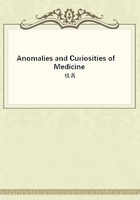
第61章
Cases of rupture of the uterus during pregnancy from the pressure of the contents and delivery of the fetus by some unnatural passage are found in profusion through medical literature, and seem to have been of special interest to the older observers.
Benivenius saw a case in which the uterus ruptured and the intestines protruded from the vulva. An instance similar to the one recorded by Benivenius is also found in the last century in Germany. Bouillon and Desbois, two French physicians of the last century, both record examples of the uterus rupturing in the last stages of pregnancy and the mother recovering. Schreiber gives an instance of rupture of the uterus occasioned by the presence of a 13-pound fetus, and there is recorded the account of a rupture caused by a 20-pound fetus that made its way into the abdomen. We find old accounts of cases of rupture of the uterus with birth by the umbilicus and the recovery of the woman. Vespre describes a case in which the uterus was ruptured by the feet of the fetus.
Farquharson has an account of a singular case in midwifery in which abdomen ruptured from the pressure of the fetus; and quite recently Geoghegan illustrates the possibilities of uterine pressure in pregnancy by a postmortem examination after a fatal parturition, in which the stomach was found pushed through the diaphragm and lying under the left clavicle. Heywood Smith narrates the particulars of a case of premature labor at seven months in which rupture of the uterus occurred and, notwithstanding the fact that the case was complicated by placenta praevia, the patient recovered.
Rupture of the uterus and recovery does not necessarily prevent subsequent successful pregnancy and delivery by the natural channels. Whinery relates an instance of a ruptured uterus in a healthy Irish woman of thirty-seven from whom a dead child was extracted by abdominal section and who was safely delivered of a healthy female child about one year afterward. Analogous to this case is that of Lawrence, who details the instance of a woman who had been delivered five times of dead children; she had a very narrow pelvis and labor was always induced at the eighth month to assure delivery. In her sixth pregnancy she had miscalculated her time, and, in consequence, her uterus ruptured in an unexpected parturition, but she recovered and had several subsequent pregnancies.
Occasionally there is a spontaneous rupture of the vagina during the process of parturition, the uterus remaining intact.
Wiltshire reports such a case in a woman who had a most prominent sacrum; the laceration was transverse and quite extensive, but the woman made a good recovery. Schauta pictures an exostosis on the promontory of the sacrum. Blenkinsop cites an instance in which the labor was neither protracted nor abnormally severe, yet the rupture of the vagina took place with the escape of the child into the abdomen of the mother, and was from thence extracted by Cesarean section. A peculiarity of this case was the easy expulsion from the uterus, no instrumental or other manual interference being attempted and the uterus remaining perfectly intact.
In some cases there is extensive sloughing of the genitals after parturition with recovery far beyond expectation. Gooch mentions a case in which the whole vagina sloughed, yet to his surprise the patient recovered. Aetius and Benivenius speak of recovery in such cases after loss of the whole uterus. Cazenave of Bordeaux relates a most marvelous case in which a primipara suffered in labor from an impacted head. She was twenty-five, of very diminutive stature, and was in labor a long time. After labor, sloughing of the parts commenced and progressed to such an extent that in one month there were no traces of the labia, nymphae, vagina, perineum, or anus. There was simply a large opening extending from the meatus urinarius to the coccyx. The rectovaginal septum, the lower portion of the rectum, and the neck of the bladder were obliterated. The woman survived, although she always experienced great difficulty in urination and in entirely emptying the rectum. A similar instance is reported in a woman of thirty who was thirty-six hours in labor. The fundus of the uterus descended into the vagina and the whole uterine apparatus was removed. The lower part of the rectum depended between the labia; in the presence of the physician the nurse drew this out and it separated at the sphincter ani. On examining the parts a single opening was seen, as in the preceding case, from the pubes to the coccyx. Some time afterward the end of the intestine descended several inches and hung loosely on the concave surface of the rectum. A sponge was introduced to support the rectum and prevent access of air. The destruction of the parts was so complete and the opening so large as to bring into view the whole inner surface of the pelvis, in spite of which, after prolonged suppuration, the wound cicatrized from behind forward and health returned, except as regards the inconvenience of feces and urine. Milk-secretion appeared late and lasted two months without influencing the other functions.